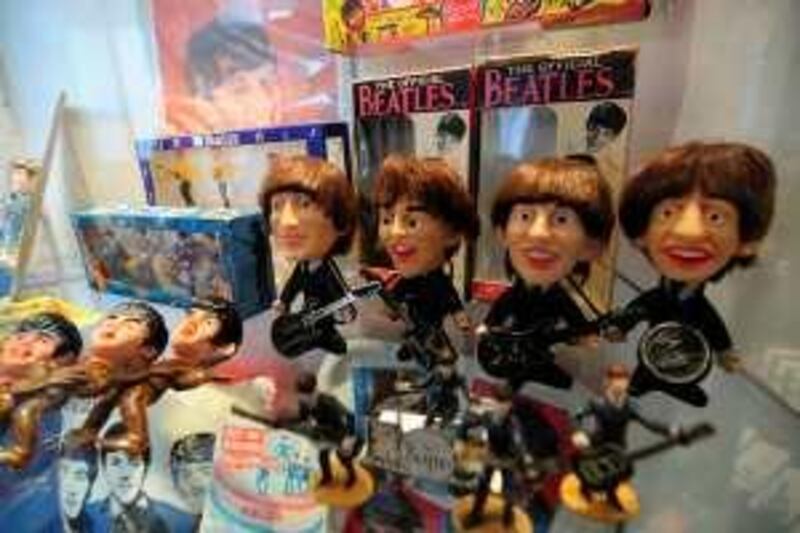HAMBURG // John Lennon once said "I didn't grow up in Liverpool, I grew up in Hamburg", and almost half a century later, the northern German port has started commemorating the role it played in shaping the biggest band in history. A five-storey museum dedicated to the Beatles opened this month on the Reeperbahn, the world-famous red-light district where they honed their rock and roll talents in 270 performances between 1960 and 1962, often playing for up to nine hours a night, before they shot to fame in 1963.
"Hamburg's association with the Beatles makes this city unique and we're finally starting to use this legacy," Bernd Zerbin, a spokesman for the privately funded Beatlemania museum, said in an interview. "There was something missing on the Reeperbahn but we're closing the gap." Last September the city unveiled a Beatles Square, circular and paved black to make it look like a vinyl record and featuring metal sculptures of the band. Then local experts on the Fab Four joined the bandwagon by launching tours of the Beatles' favourite haunts and the four night clubs where they played.
No one seems able to explain why it has taken Hamburg so long to market itself as the place where the Beatles started out. "For years, Beatles fans have been wandering the streets around here helplessly looking for the clubs where they played their gigs," said Peter Paetzold, 58, a guide who started offering Beatles tours in May. "Now that we've got the museum I think Beatles tourism will really take off. "
The museum, which has an inflated Yellow Submarine suspended over its entrance, contains memorabilia such as Ringo Starr's 12-string guitar, a 1961 German record contract and a postcard written by Ringo to his grandmother in Liverpool that contains three spelling mistakes in the first sentence alone: "The wether hear is not to bad [sic]." There's a karaoke studio where visitors can record their renditions of Hard Day's Night and Let It Be, and the museum devotes an entire room to the album Sgt. Pepper's Lonely Hearts Club Band that allows fans to add their own head to the dozens of famous people on the iconic album cover. The band had only just named itself The Beatles when the Hamburg entrepreneur Bruno Koschmider hired them from Liverpool to appear at the Indra on August 17 1960, for what became a 14-week residency.
They played cover versions of rock and roll songs for 106 nights there and in another club, the Kaiserkeller, until November 30, learning how to handle rough audiences, developing their musical style and image and acquiring the self-confidence they needed to take on the world. The Beatles returned for more stints in 1961 and 1962, playing at the Top Ten Club and the Star Club. It was a world of sex, drugs, rock and roll, bar brawls and street fights, and the boys from Liverpool, in their late teens and early twenties at the time, immersed themselves in it wholeheartedly.
Their life in Hamburg was anything but luxurious. In 1960, they were put up in rooms behind the screen of a local cinema, and had to share the toilet with the cinema goers. Yet these were formative years for the band, say Beatles historians, because they met and jammed with musicians from all over the world. And the city's club managers were quick to recognise the band's commercial potential. Horst Fascher, who managed the Star Club where the Beatles performed in 1962, said: "I noticed that the girls ran after the Beatles and where the girls go you get boys because they run after the girls. The Beatles were a huge magnet for the area."
Hamburg in the 1960s was famous the world over for its permissiveness, which helped the city's nightclubs to attract top stars such as Jerry Lee Lewis, Bill Haley, Little Richard and Fats Domino. "It's one of the world's biggest ports and this together with the red-light district attracted a huge variety of nationalities, a strong youth scene and many bands. They learnt from each other, copied each other's styles, and a lot of music business was done here," Mr Zerbin said. "This place was extremely important for their career in a lot of ways." Those heady days of rock and roll have long since gone and the Reeperbahn has fallen on hard times.
Cabarets have given way to discount stores and the area has a growing reputation for violence. "It's mainly foreign tourists who are interested in Hamburg's links with the Beatles," said Mr Paetzold. "Germans who are old enough to remember that the band played here don't dare come to the Reeperbahn because they think they'll get stabbed." Hamburgers hope the new Beatles marketing drive will breathe new life into the Reeperbahn and even attract families and school classes, at least during the daytime, before the neon lights come on.
Now all that is missing is a visit by Paul McCartney or Ringo Starr, neither of whom showed up to the official opening of Beatlemania. "It would of course be a huge accolade if they come one day," said Mr Zerbin, pausing to listen to the sublime refrain of Strawberry Fields Forever. dcrossland@thenational.ae






